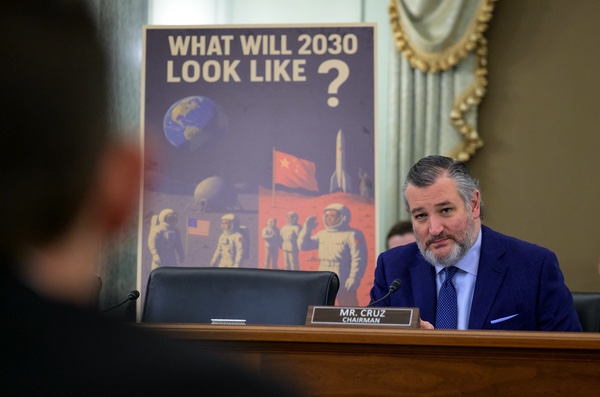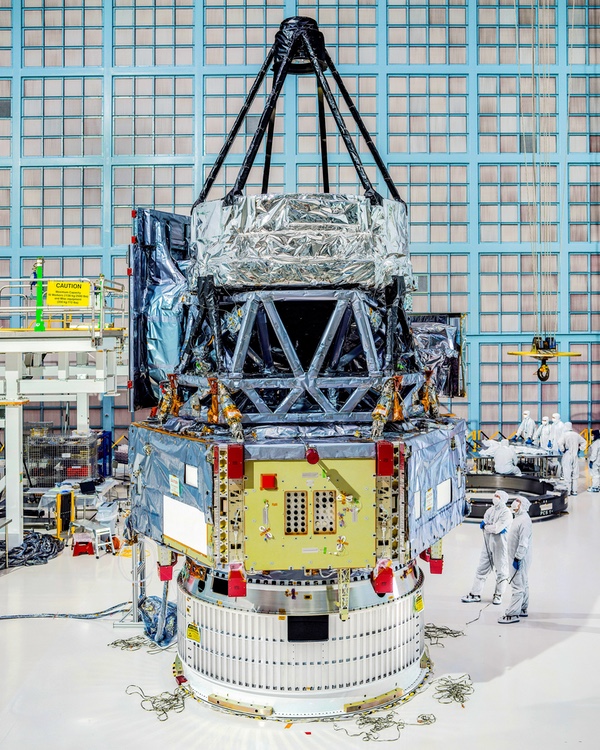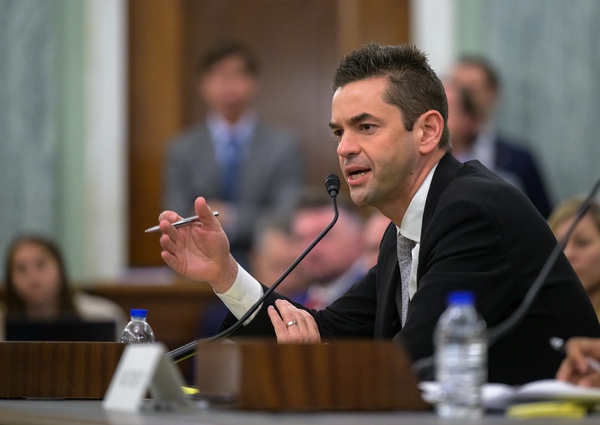All of the above, or none?by Jeff Foust
|
| “As the President stated we will prioritize sending American astronauts to Mars. Along the way, we will inevitably have the capabilities to return to the Moon,” Isaacman said in his opening testimony. |
Then there was his choice for NASA administrator, Jared Isaacman. A billionaire and two-time private astronaut, he was both famous and unfamiliar: famous for his spaceflight exploits as well as his philanthropy and business success, but an outsider when it came to NASA. That turned him into something of a blank slate for people to project their hopes or worries upon: commercial space advocates hoped his spaceflight experience would translate into new opportunities, while scientists wondered if his interest extended beyond public support last year for the Chandra X-Ray Observatory and Hubble Space Telescope.
Isaacman finally got an opportunity to fill that slate himself last week when he testified at a confirmation hearing for his nomination by the Senate Commerce Committee. But even before he uttered a word in a crowded Senate hearing room—attended by both the four NASA Artemis 2 astronauts as well as his crewmates from the Inspiration4 and Polaris Dawn missions—there was controversy about his comments.
“As the President stated we will prioritize sending American astronauts to Mars. Along the way, we will inevitably have the capabilities to return to the Moon and determine the scientific, economic, and national security benefits of maintaining a presence on the lunar surface,” he stated in his prepared opening statement. Those comments, which leaked out the evening before the hearing, appeared to suggest that a return to the Moon was secondary to human missions to Mars, raising doubts about the future of Artemis.
The chairman of the committee, Sen. Ted Cruz (R-TX), seized on that, citing China’s own plans to send humans to the Moon by 2030. He unveiled a poster—using AI-generated art, he said—showing on the left-hand side American astronauts on the surface of the Moon and, on the right-hand side, Chinese astronauts on the Moon. “What Will 2030 Look Like?” the posted stated.
“Mr. Isaacman, if China beats us to the Moon, what consequences might America face?” he asked.
“We certainly cannot lose,” Isaacman responded, citing the “ultimate high ground” of space and the potential value of resources like helium-3 on the Moon.
| “I think if we can concentrate our resources of the world’s greatest space agency, we don’t have to make a binary choice of Moon versus Mars or Moon has to come first versus Mars. I think we can be paralleling these efforts,” Isaacman said. |
Cruz noted that, when they met privately before the hearing, Isaacman said that if the president saw Chinese astronauts on the Moon on television before Americans returned, he would be fired that day. “There seems to be a bit of tension between the commitment you made in my office and your testimony,” Cruz concluded. “Will you maintain course with the Artemis program so that we can return American astronauts to the Moon before President Trump leaves office?”
Isaacman’s answer to the question of Moon-first versus Mars-first appeared to be “yes.” “I don’t think we have to make any tough trades here, senator. I think if we can concentrate our resources of the world’s greatest space agency, we don’t have to make a binary choice of Moon versus Mars or Moon has to come first versus Mars. I think we can be paralleling these efforts and doing the near impossible, which is exactly why the American taxpayers funded NASA in the first place.”
He added: “Senator, I only see the left-hand portion of that poster.”
 Sen. Ted Cruz (R-TX) and his poster showing two visions for lunar exploration in 2030. (credit: NASA/Bill Ingalls) |
Cruz pressed him on that: barring a “dramatic” increase in NASA’s budget, how can human missions to the Moon and Mars be done simultaneously? Isaacman didn’t offer details, instead pointing to how NASA went from Alan Shepard’s suborbital flight to the Apollo 11 lunar landing in a little more than eight years.
What was clear, though, is that whatever plan he had for simultaneous Moon and Mars programs, its progress in the near term would look similar to Artemis. “Do you believe that the current Artemis architecture, featuring the SLS rocket or Orion spacecraft, is the best and fastest way to beat China to the Moon?” asked Sen. Jerry Moran (R-KS), who not only serves on the Commerce Committee but is also chair of the appropriations subcommittee that funds NASA.
“Senator, this is the current plan,” Isaacman responded. “I do believe it is the best and fastest way to get there.” He added, though, that the SLS/Orion approach was not “the long-term way of getting to and from the Moon and to Mars with great frequency” but didn’t say when he believes it should be set aside in favor of alternatives.
He expressed a desire, though, to do things differently, albeit in unspecified ways, citing cost and schedule overruns. “We do have problems here. Presidents have called for a return to the Moon and a path to Mars since 1989,” he told Sen. Gary Peters (D-MI). “We’ve spent a lot of money and we haven’t gotten this crew around the Moon,” motioning to the Artemis 2 astronauts, “let alone landing on it.”
“If I am confirmed,” he continued, “I absolutely am going to roll up my sleeves and get in the trenches with the best and brightest and figure out where we have our program challenges, what’s impeding progress, clear those obstacles, and get back to delivering on the mission.”
It was clear, though, he was unwilling at the hearing to take aim at any specific program, even the lunar Gateway, a common target of critics of the current Artemis architecture. “As administrator, are you going to cancel the Gateway program?” Cruz asked late in the hearing.
“Senator, I have no intention as of now to say that I would cancel any program,” Isaacman responded.
The only other area that got nearly the same level of attention was plans for the future of the International Space Station and a NASA presence in low Earth orbit. He distanced himself from comments made in February by Elon Musk, CEO of SpaceX and a close advisor to President Trump, that called for deorbiting the ISS as soon as possible, which he deemed to be in about two years.
“I am familiar with Mr. Musk’s remarks on that,” he said when asked about those comments by Sen. Tammy Duckworth (D-IL). “I would like to understand his rationale behind that.”
He did not, though, share Musk’s opinion about the ISS. “I do not believe we should deorbit it now. I think we need to make the most use of the space station while we have it and figure out what we can accomplish in the unique environment of microgravity,” he said.
He later told Cruz that “we cannot cede low Earth orbit to the Chinese,” when the senator asked about a potential gap between the ISS and commercial successors, but did not elaborate on how he would avoid that gap.
Isaacman appeared to support commercialization efforts in LEO, calling for a “thriving space economy in low Earth orbit.” Curiously, though, he appeared to suggest that NASA should financially benefit from that work, saying that unlocking the “true economic potential” of space could potentially lead to NASA becoming “a financially self-sustaining agency.” He did not elaborate on this point and members of the committee did not press him on that.
The split with Musk came as other members of the committee sought to understand Musk’s ties to, and influence on, Isaacman. When asked by Peters if he had any communications with Musk about NASA since the nomination was announced, he responded, “Not at all.”
However, Sen. Ed Markey (D-MA) pressed Isaacman on whether Musk was present when then President-elect Trump offered Isaacman the NASA nomination last fall during a meeting at Mar-a-Lago. “Senator, I was interviewed by the President of the United States,” Isaacman.
The two went back and forth for nearly a minute, with Markey repeatedly asking if Musk was in the room when Trump offered the nomination and Isaacman repeatedly responding that he was meeting with Trump. “I assume that you don’t want to answer the question directly because Elon Musk was in the room,” Markey concluded.
 The Roman Space Telescope, scheduled for launch in the fall of 2026, is threatened with cancellation in the proposed fiscal year 2026 budget. (credit: NASA/Chris Gunn) |
Golden age versus dark age
The focus on Artemis, the ISS, and Musk meant that many other NASA issues were overlooked at the hearing. Aeronautics, for example, did not come up despite Isaacman’s background as a pilot, and there was little discussion about the agency’s space technology portfolio beyond brief discussions about nuclear propulsion. (Still, one senator managed to find time to ask if Isaacman had seen The Martian—yes—and another asked who was his favorite character in Armageddon—Bruce Willis’s oil driller, not Billy Bob Thornton’s NASA administrator.)
| “I do believe that the President is looking to usher in a golden age of science and discovery,” ISaacman said. “I’m passionate about science.” |
There was also only a brief discussion about NASA science, one where Isaacman was upbeat. “NASA will be a force multiplier for science,” Isaacman said in his opening remarks. “We will leverage NASA’s scientific talent and capabilities to enable academic institutions and industry to increase the rate of world-changing discoveries. We will launch more telescopes, more probes, more rovers and endeavor to understand our planet and the universe beyond.”
Those comments came amid concerns that the White House was considering major cuts in NASA’s science programs: as much as 50%, by some reports. “Will you be an advocate for science within the administration?” asked Sen. Amy Klobuchar (D-MN).
“I do believe that the President is looking to usher in a golden age of science and discovery,” he responded. “I’m passionate about science. I would love nothing more than to continue to see NASA go out and try to unlock the secrets of the universe.”
“NASA has a pretty extraordinary budget,” he said later to Peters. “With that budget and those resources available, I do believe we can do the near-impossible. I think we can have multiple flagship scientific missions at once, which means we can have multiple space exploration missions at once, and try to solve the space economy in low Earth orbit.”
The timing of the hearing was fortuitous for Isaacman. The next day, the Office of Management and Budget sent its draft budget proposal for fiscal year 2026, known in policy circles as a “passback,” to agencies like NASA. That offers agencies a final opportunity to seek changes before the formal release of the budget.
That passback, while not made public, leaked out nonetheless. For NASA, the White House was proposing a roughly 20% cut, to around $20 billion, for the agency overall. However, the passback realized earlier fears of a more dramatic cut in NASA science, slashing it from about $7.3 billion in 2025 (the same as 2024, thanks to a continuing resolution that funded NASA and other agencies at 2024 levels) to just $3.9 billion in 2026.
The proposal would cancel an astrophysics flagship mission, the Nancy Grace Roman Space Telescope, despite the mission being on budget and on schedule for a launch in the fall of 2026. Also on the chopping block is Mars Sample Return, as NASA studies ways to get that effort back on track (see “Two (or more) ways to get samples back from Mars”, The Space Review, January 13, 2025) and as China works on plans to return samples by the early 2030s. Many of smaller missions, either in early stages of development or in extended missions, would also be threatened with termination.
“The proposed budget from within the White House—which cuts NASA science by 47%—would plunge NASA into a dark age,” The Planetary Society said in a statement as details about the passback leaked out.
Members of Congress expressed similar concerns. “Donald Trump’s attack on NASA amounts to a form of national self-destruction and will have untold effects on the country’s scientific efforts, research objectives, and our standing around the globe,” said Sen. Adam Schiff (D-CA).
| “Donald Trump’s attack on NASA amounts to a form of national self-destruction and will have untold effects on the country’s scientific efforts, research objectives, and our standing around the globe,” said Sen. Schiff. |
On Monday, three Democratic members of Maryland’s congressional delegation—Sen. Chris Van Hollen and Reps. Steny Hoyer and Glenn Ivey—stood outside the main entrance to the Goddard Space Flight Center, discussing their worries about the budget, including its implications for Goddard. “If you cut the science programming in half, you hurt our country in many ways,” Van Hollen said. “You hurt our national security. You hurt our innovation economy. You hurt our leadership around the world.”
They mentioned competition with China, a theme of Isaacman’s confirmation hearing. “Are we going to decide that we want to continue to maintain the lead in science and technology over the rest of the world, or not, because right now, China’s right at our heels,” said Ivey, whose district includes Goddard.
They thought that Republicans—in the majority in both the House and Senate—would support efforts to restore cuts to NASA science, citing “the national security and other interests of the United States,” as Van Hollen put it. Republicans have, by and large, been quiet about the proposed cuts so far, as has Isaacman, who has kept a low public profile outside his confirmation.
Keeping all of NASA’s major programs on track in that fiscal climate is a task that, to borrow a phrase Isaacman used several times in his confirmation hearing, will be near-impossible.
Note: we are now moderating comments. There will be a delay in posting comments and no guarantee that all submitted comments will be posted.
